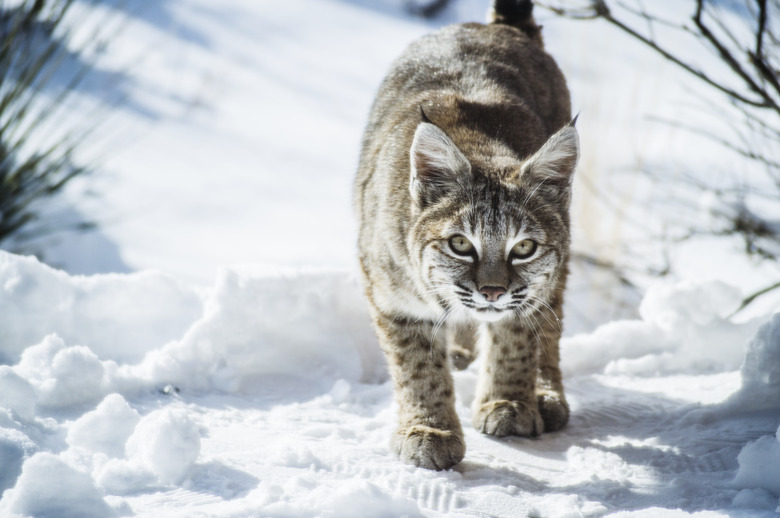Species Of Bobcats In Pennsylvania
As a carnivorous mammal, the bobcat, Lynx rufus, lives in areas from southern Canada to parts of Mexico. Except for areas around the Great Lakes, the central valley in California, parts of Kansas and places on the East Coast, bobcats live in Pennsylvania. Bobcats and lynx, though related, are not the same animal. Canadian lynx, __Lynx canadensis,__ appear larger because of longer legs and have a black tail tip that looks as if it's been dipped in ink.
TL;DR (Too Long; Didn't Read)
Lynx, unlike bobcats, are a threatened species. The bobcat is more aggressive than the lynx and often displaces the secretive, forest-dwelling feral cat from its home. Both wildcats are about the same size, with lynx having longer legs, which gives them the appearance of being bigger. Alhough Canada lynx have a bigger range than bobcats, they're the only known wildcat species in Pennsylvania, even though people have mistakenly reported sightings of pumas or mountain lions in the region.
What They Look Like
What They Look Like
A bobcat looks like an oversized house cat, weighing between 20 and 30 pounds with a black-spotted brown coat that can turn gray in the winter. Though a bobcat has a bobbed, black-tipped tail, the black is only on the tip instead of the wider band found on a lynx's tail. With large ears, and tufts of fur at the tips, the bobcat also sports ruffs of fur on its cheeks. It stands about 2 feet tall from shoulder to its large paws.
Foods Bobcats Eat
Foods Bobcats Eat
As nocturnal creatures, bobcats hunt at night, eating a wide variety of small mammals. Even though bobcats most common food is the cotton-tail rabbit, it will also eat raccoons, moles, squirrels, skunks and woodchucks. A patient hunter, the bobcat waits motionless until it pounces on its kill, killing it by grabbing its neck and cutting the creature's spinal cord. Bobcats also eat birds and reptiles when they can catch them. Sometimes, the bobcat even goes after larger prey, such as small deer, which allows it to store the remainder to eat later.
Bobcat Life Cycle
Bobcat Life Cycle
Bobcat mating season occurs during a small window between February and March. Females give birth in late April or early May to a litter that ranges in size from one to seven kittens. Average litters typically have two to four kittens. Born with their eyes closed, kittens first open their eyes 10 days after birth and are weaned from nursing after about 10 weeks. Bobcat kittens stay with the mother for about a year.
Behavior and Territory
Behavior and Territory
Bobcats mark their territories, mountains, forests or swamps like big cats do. They scratch marks onto trees and apply urine, feces and scent markings on scrapes, piles or mounds of leaves and dirt. Bobcats territories range from a square mile to 20 miles, depending on the season and geography, and their territories often overlap with females or a single male. As solitary creatures, bobcats swim well and can climb trees when needed. During the day, they often rest on ledges or in locations that give them a good view of their surrounding territory.
Cite This Article
MLA
Brenner, Laurie. "Species Of Bobcats In Pennsylvania" sciencing.com, https://www.sciencing.com/species-bobcats-pennsylvania-8624779/. 17 April 2018.
APA
Brenner, Laurie. (2018, April 17). Species Of Bobcats In Pennsylvania. sciencing.com. Retrieved from https://www.sciencing.com/species-bobcats-pennsylvania-8624779/
Chicago
Brenner, Laurie. Species Of Bobcats In Pennsylvania last modified March 24, 2022. https://www.sciencing.com/species-bobcats-pennsylvania-8624779/
